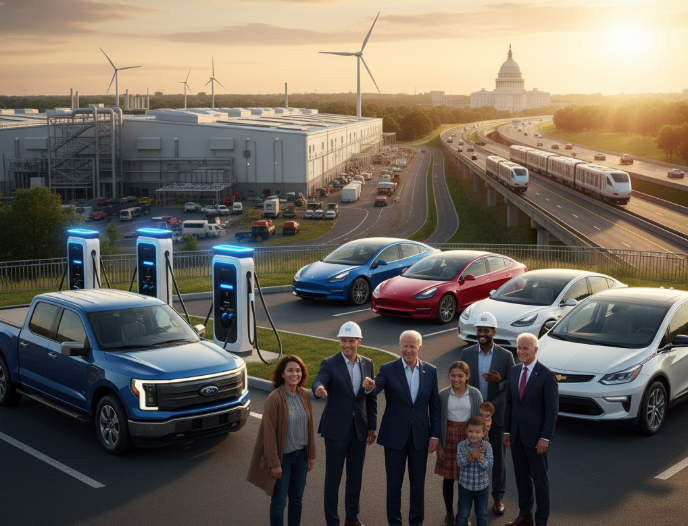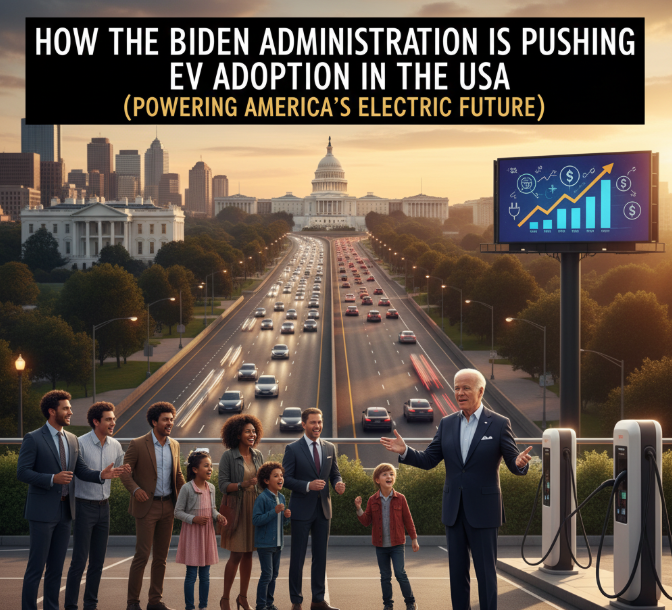Introduction
Electric vehicles (EVs) are no longer a futuristic concept—they are here, and they’re rapidly becoming part of everyday life in the United States. Over the past few years, the push toward cleaner energy and modern transportation has gained speed, and at the center of this movement is the Biden administration. President Joe Biden has made it clear that EV adoption is not only about reducing pollution—it’s also about creating jobs, strengthening the economy, and ensuring the U.S. remains competitive in the global auto industry.
This article takes a detailed look at how the Biden administration is driving EV adoption, the policies shaping the market, the incentives for consumers, the challenges ahead, and what this all means for the future of transportation in America.
The Biden Administration’s EV Goals
When President Biden took office, one of his top priorities was tackling climate change. Transportation, being the largest source of greenhouse gas emissions in the U.S., became a key target.
Here are some of the administration’s major EV goals:
- 50% of all new vehicle sales to be electric by 2030
- 500,000 EV charging stations nationwide by 2030
- Net-zero carbon emissions by 2050
- U.S. to lead in EV battery production and supply chains
These goals are ambitious, but the administration has been putting policies, investments, and regulations in place to make them achievable.
Federal Incentives and Tax Credits
Updated Federal EV Tax Credit
One of the strongest tools to boost EV sales has been tax incentives. The Inflation Reduction Act (IRA) of 2022 reshaped the EV tax credit system.
Here’s how it works:
- Up to $7,500 federal tax credit for new EV purchases
- $4,000 federal tax credit for used EVs (under $25,000)
- Income limits apply: $150,000 for individuals, $300,000 for joint filers
- Vehicle price caps: $55,000 for cars, $80,000 for SUVs and trucks
- EVs must be assembled in North America to qualify
This credit makes EVs more affordable for middle-class families and ensures U.S.-made vehicles are prioritized.
Building a Nationwide Charging Network
The EV Charging Challenge
One of the biggest concerns for EV buyers is range anxiety—the fear that their car will run out of power without a nearby charging station. The Biden administration is addressing this through massive investments in charging infrastructure.
National Electric Vehicle Infrastructure (NEVI) Program
- $7.5 billion dedicated to building 500,000 EV chargers nationwide
- Focused on highways and major travel corridors
- Chargers every 50 miles along interstate routes
- Federal and state governments partnering with private companies
Fast-Charging Expansion
The administration is promoting DC fast chargers, which can recharge most EV batteries to 80% in 20–40 minutes. This is critical for long-distance travel.
Strengthening U.S. EV Manufacturing
Bringing Jobs Back Home
The Biden administration isn’t just focused on EV adoption—it also wants to ensure the U.S. builds these vehicles and their parts domestically.
Key initiatives include:
- $50 billion in investments for EV manufacturing and battery production
- Tax incentives for companies that set up EV plants in the U.S.
- Support for unionized labor to ensure fair wages in the EV industry
Battery Supply Chain
China currently dominates EV battery production, but the administration is working to reduce dependency by:
- Encouraging domestic mining of lithium, cobalt, and nickel
- Supporting battery recycling programs
- Funding battery innovation research in U.S. universities and labs
Regulations and Standards
Tighter Emission Rules
The Environmental Protection Agency (EPA) under Biden has proposed stricter vehicle emission standards, which effectively push automakers to produce more EVs.
Automaker Partnerships
Several automakers—including Ford, GM, Tesla, and Stellantis—have signed agreements with the administration to increase EV production.
Federal Fleet Electrification
The federal government itself is transitioning its fleet of 650,000 vehicles to EVs, setting an example for states and private companies.
State-Level Support Boosted by Federal Policies
While federal action is critical, states are also playing a big role. The administration supports partnerships with states like:
- California – Leading with strict emissions standards and rebates
- New York – Expanding EV rebates and charging programs
- Texas & Florida – Rapidly expanding charging infrastructure
Federal funds are helping states meet local EV goals while creating consistency across the country.
How Consumers Benefit from Biden’s EV Push
Lower Costs
- Upfront tax credits reduce EV prices
- EVs have lower fuel and maintenance costs than gas cars
- Over the lifetime of a vehicle, EV owners can save $6,000–$10,000
More Choices
- Automakers are releasing EVs in all categories: sedans, SUVs, trucks, and even luxury cars
- By 2025, over 100 EV models will be available in the U.S.
Better Charging Access
- Charging networks are expanding rapidly
- Federal investments mean rural areas and smaller towns will also have access

Key Challenges Ahead
Even with strong policies, several hurdles remain:
- High Upfront Costs – EVs are still more expensive than many gas cars.
- Battery Supply Chain – Securing raw materials like lithium may be challenging.
- Charging Infrastructure Gaps – Building 500,000 chargers is ambitious but complex.
- Public Awareness – Many people still don’t fully trust EV technology.
- Grid Readiness – U.S. power grids must handle increased demand from EV charging.
Table: Comparing EV Adoption Progress
| Factor | Before Biden (2020) | Current (2025) | Target (2030) |
|---|---|---|---|
| EV Market Share | 2% | ~10% | 50% |
| Public Charging Stations | ~100,000 | 160,000+ | 500,000 |
| Federal EV Tax Credit | Limited to certain automakers | Expanded to all qualifying models | Continue until 2032 |
| Federal Fleet Electrification | Minimal | Transition underway | 100% electric fleet |
Infographic Idea (for visual representation)
Title: How the Biden Administration is Driving EV Growth
- Top Section: EV adoption goals (50% sales by 2030, 500,000 chargers)
- Middle Section: Tax credits and consumer benefits
- Bottom Section: Job creation and manufacturing investments
Public Response and Market Trends
- EV Sales Growth: EV sales hit over 1 million units in 2023, doubling from two years earlier.
- Automaker Shifts: GM plans to sell only zero-emission vehicles by 2035; Ford is investing $11 billion in EV plants.
- Consumer Interest: A 2024 survey showed 70% of Americans would consider an EV for their next vehicle.
This momentum indicates that the Biden administration’s efforts are shaping both consumer perception and industry direction.
The Global Competition Factor
Biden’s EV strategy isn’t just about the environment—it’s also about staying competitive with China and Europe, where EV adoption is already higher.
- China controls 60% of battery manufacturing
- Europe offers stronger EV incentives and stricter emission rules
- U.S. policies are designed to catch up and keep American automakers globally competitive
What the Future Looks Like
Looking forward, we can expect:
- Wider EV availability across price ranges
- Faster charging technologies (10–15 minutes to full charge)
- Greater battery efficiency and recycling solutions
- Expansion of renewable energy to power EVs sustainably
If the administration continues on its current path, EVs could become the default choice for Americans within the next decade.
Conclusion
The Biden administration’s push for EV adoption in the U.S. is a multi-pronged strategy combining incentives, infrastructure, manufacturing, and regulation. While challenges remain, the momentum is undeniable.
By making EVs affordable, accessible, and practical, the government is not only addressing climate change but also creating jobs, strengthening the auto industry, and keeping the U.S. competitive on the global stage.
The road ahead may not be easy, but the direction is clear: the future of American transportation is electric.

